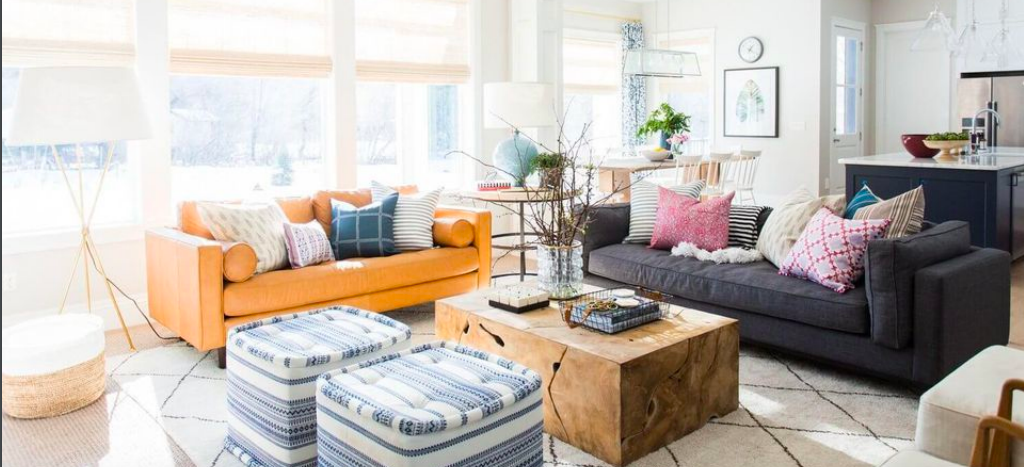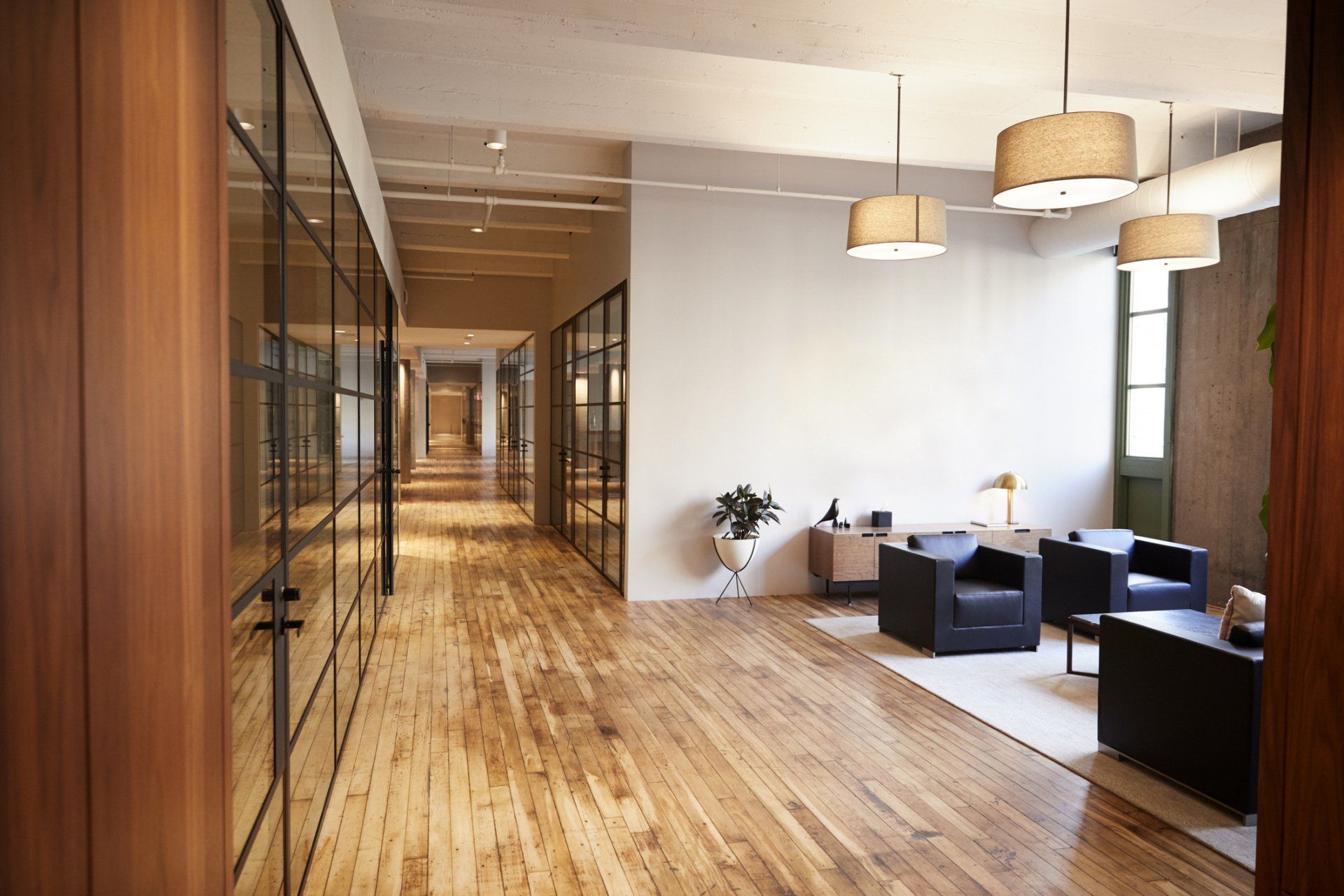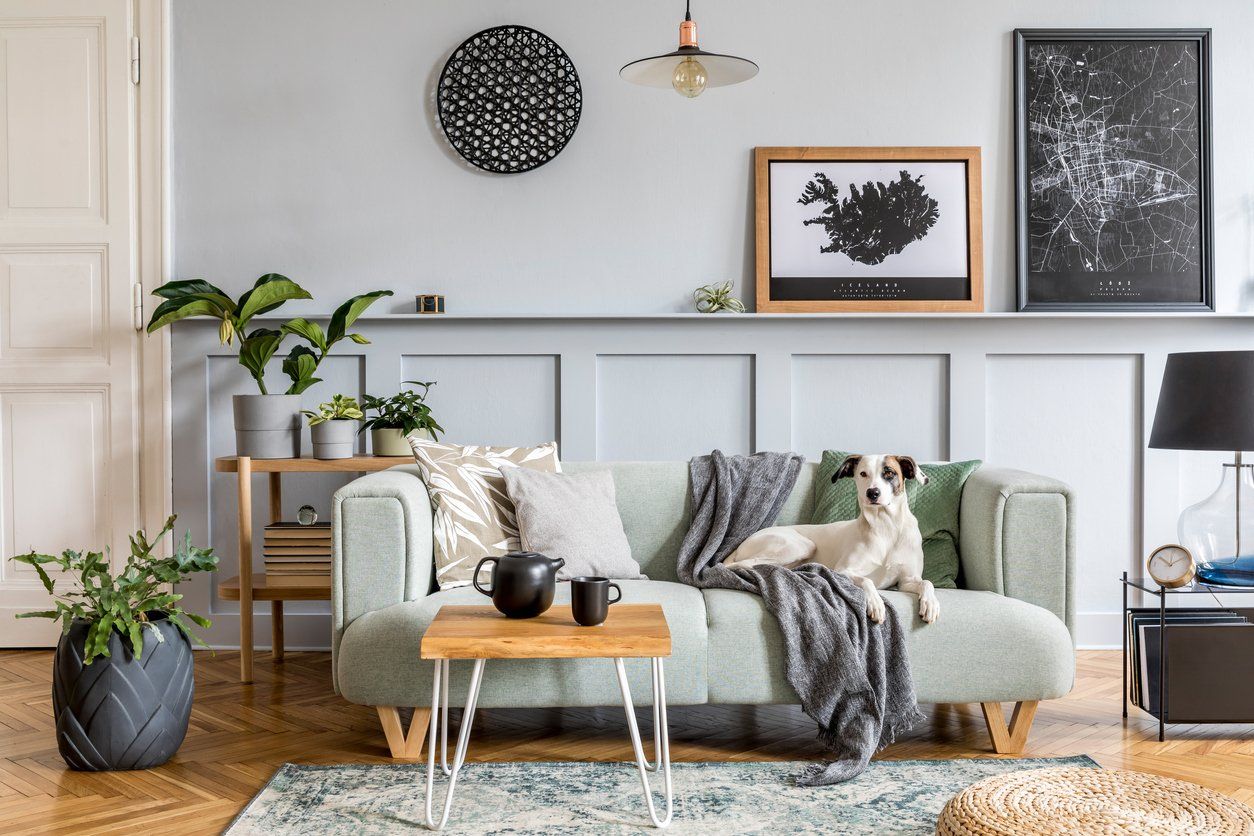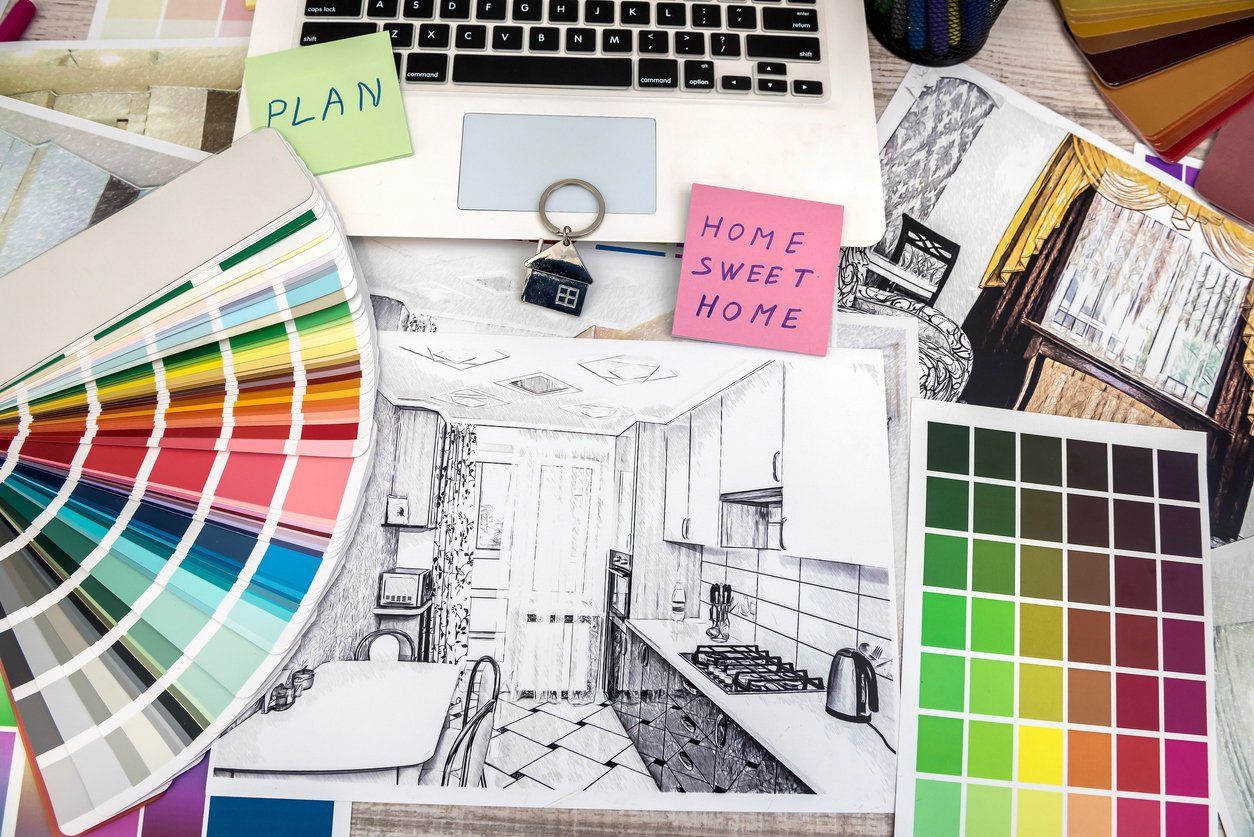Blog

By Christian Harris
•
August 26, 2021
Patterns on Patterns Using multiple patterns in the same space used to be a big “no” in design rules—interior spaces encouraged more simplicity with a few bolder accents to draw attention. Now, patterns are embraced as a stylistic scheme in its own! Mixing patterns and textures invites more visual and physical interest into any space. Experiment with size and shape, material and décor, but don’t lose sight of your color scheme which will tie everything together… introducing more and more colors defeats the cohesion that your color scheme creates and makes your patterns jumbled. Remember as well to include plenty of block-colors in your design, so that your patterns add to rather than overwhelm the room.

August 12, 2021
Any room in your house should invite comfort and a positive mood—that’s the goal of a “home”! To create a safe space that you can rely on to put you in a good headspace and relieve you from the stresses of outside influences. The design of your room is the best way to foster that comfort and positive mood that you need… here are a few ideas that will help your room get there! Greenery For both physical and emotional reasons, plants can have a big impact on the “health” of your room. Greenery provides a healthy circulation and cleansing of the air inside the room, reducing pollutants and giving you healthy air to breathe. Plants have also been proven to help boost your mental health! They can lower anxiety—the soil and the “outputs” they release into the air are all-natural particles that can calm your heart, decrease stress, help with sleep, and more. The deep and vibrant colors they offer are also helpful to setting a calming, rich sense of comfort and control. In addition, caring for plants increases productivity, memory and attention span for those who struggle to stay organized! Comfort Items An easy addition to any room is comfort items. Prioritize comfort as much as you can! Style around it if you have to. Provide little relaxing elements all over your space that address each of your senses. Throw pillow and blankets can soften visual perception as much as physical touch! Healthy, natural lighting promotes vitamin D, and the brightness uplifts the brain. Candles invite gentle and pleasant smells as well as an aesthetic charm, and personalized photos encourage happy memories. Don’t overwhelm your space, but offer enough opportunities for relaxation within the room that it becomes a haven for any day! Good Lighting Again, lighting is a huge element of good moods and a comfortable environment. Invite in as much natural light as possible! Big windows with light curtains, light colors for walls and décor, good lamps and other fixtures will each contribute a healthy amount of light into a room. Dark rooms make for darker, sleepier moods; light rooms encourage light and energized moods that will help you stay upbeat and calm! Once you’ve decided what kind of design will foster your comfort best, look at these ideas for planning your space to put your whole idea together. Whatever you choose to use to welcome comfort, enjoy the confidence that comes with a well designed room for your physical and emotional wellness.

August 12, 2021
One of the newest phenomenon that has happened in the last few years, and has accelerated since the pandemic has been the value of existing and new homes becoming almost too expensive for many people to afford. There has been housing inflation in the past but it seems that many components of a home have grown scarcer (i.e. lumber and wood products) and the lack of skilled labor has pushed the affordability index much higher than in the past. Dependent upon the area in which you live housing could have increased by as much as 48-52% during this period of time. As government officials, builders, and consumers have approached this problem and hope to bring reason to a solution, one idea has become a possible key to solving the problem, one that also helps provide more space for people to live and also helps homeowners afford a home. This solution is in an accessory apartment or ADU. They actually have a long history in our country with a Carriage House, being used as an apartment over a garage, or actually over a stable where carriage and horses where kept. The upstairs on these units often housed people who worked in the home, garden, or with the transportation of whomever lived in the main house. This use of an accessory way to house additional people actually went out of favor for a century or more. Only during the last 10-20 years has there been new interest in the use of this type of housing being used by a homeowner. Now, the accessory apartments may take the form of a basement apartment (using all or part of a homeowners basement), a tiny (cute) house on the same property as the existing home, or an apartment that is over the garage. All of these options can be available to a homeowner to provide additional income to pay their mortgage. Whatever form these apartments take, they are part of the property of the existing home. They cannot be sold separately and the owner of the home also owns the accessory apartment. These homes can be called, mother-in-law apartments, secondary dwelling units or hundreds of other names. The main reason that a homeowner would consider this option is to either gain income or to house someone who is a member of their family. While there are major advantages to this arrangement, there are often deterrents to their use. Almost every city entity has written code for accessory apartments. You must conform to their code in order to build and rent this apartment. Some of these might be: how many square feet has to be in the apartment, separate entrances, provision for kitchens and bathrooms, ceiling height (no 7 foot ceilings), and very important provision for parking. This can be as few as one parking space for the apartment, or as many as three. Usually accessory apartments must continue to look like one primary residence and must have the same address. The apartment must not be used for short term rental, (Air B&B), and there must be a separate entrance with a fire rated door to the additional apartment. Additionally a maximum of one accessory apartment will be allowed in a single family home. If a homeowner begins to see the benefit or necessity for an apartment they then need to assess several things. The city that the home is in may be open to an accessory apartments and they will always have an application, and provisions that must be met. For example, the owner must submit an application, floor plans, an exterior rendering and of course there are always FEES. There is an example of an application for an accessory dwelling unit below. This actual city is in Utah County but similar applications are required in almost every city in Utah. This is the first and most important step in the process because if the city you are located in will not allow an apartment then you cannot continue. The next step is to consider your ability to finance this alteration to your property. Shelby Coolidge, who is an experienced loan provider in Utah for residential and commercial properties, spoke with me about how to do this. Any homeowner that has a good credit rating, and adequate equity for a refinance of their home could potentially do this. There are some houses that the owners have not had enough money to adequately repair, paint, or fix parts of their home and therefore the home has declined in value and beauty. By approaching a refinance with the purpose of upgrading the upstairs of their home and building the ADU it can provide enough income to pay for the new mortgage. Many times, lots have a smaller front yard but have good property depth behind their house. This could be used for a tiny house and provide aging parents or a college student with a place to stay that won’t put them in more debt. Homes have spacious basements that could be divided into two parts, one for the homeowners to use for their purposes and the rest into that ADU. The final, and perhaps best way to access this opportunity, would be to either put another story on a detached garage or to construct another garage and put an apartment above. So, to the point of why a homeowner would do all of this in order to have another person living close to them. Rental rates in Utah have gone up faster than even housing costs, with a two bedroom apartment, in many cities, renting from $1200.00 to $1400.00/month. If the renter needs more room than the normal two bedroom you could be getting closer to $1600.00/month. If a homeowner goes to the effort to remodel and include an apartment as part of their property they can expect to be able to finance, at least, $100,000 in additional mortgage without having to pay more per month. Their new apartment will be the financial engine behind this windfall. Whichever path you choose for accessing the equity in your home to provide space and income there’s an opportunity to design beauty and function into your NEW HOME. Complete Design has years of experience in imagining and creating not only beautiful homes, but also bringing new life through remodeling and adding accessory apartments. The use of your equity to improve your existing home and create rental income can be a perfect use of this process. Whatever you are thinking about, we can help it become a reality through design, finance, and the actual building process. Call us at Complete-Dezign for help moving forward.

August 5, 2021
Making a room feel comforting, exciting, unique or personal shouldn’t have to break the bank. Expenses for interior design elements can add up quickly! Here are a few tips for creating the look and feel you want on a manageable budget. Upscale Vintage One man’s throw-away’s are another man’s décor! Never underestimate a good garage sale, thrift shop or antiques store. Hundreds of gems lie in these piles of vastly unappreciated pieces. Hunting for such gems requires a bit more time and patience than online shopping entices, but is well worth the reward of a deal on a piece that is entirely functional and visually beneficial. The vintage look adds a feeling of well-worn comfort, unique taste, and even an appreciation for time and history. Devote a little energy to brushing off some dust, applying some shine or paint, and making small repairs to items that need just a little TLC to get them to the perfect decorative quality you need for your room. Embrace Minimalism The minimalist “movement” has swept the 21st century. Modern or contemporary style encourages clean lines, neutral tones and an emphasis on space. Best of all, it encourages a lesser amount of decoration. Embrace this easy and popular style! Consider how you can elongate your space while creating enough color and personalization to keep it homey and inviting. Emphasize simplicity. Minimalize the décor that can become overwhelming in some rooms—collages of photos, shelves of books and souvenirs, etc. Allow yourself a break from expensive additions to a room that doesn’t need them! Create a Focal Point Another popular trend for interior design today is a ”focal point”: an area of the room that draws the eye immediately. With one area occupying the majority of one’s attention, you can save on what would otherwise be a room full of pricey ornaments. Focal points don’t have to be expensive, either! An accent wall of fun, patterned wallpaper, a large mirror or painting, a chandelier or hanging, a corner dedicated to books or plants or collections of whatever you are passionate about… any of these serve as a great focal point for you and your visitors! Explore these various ways to contribute to your interior design dreams without the stress of a high bill at the end of it. Try out these wallcoverings as a way to experiment with a vintage look, a minimalistic room with an intricate accent wall, or a means of focal emphasis.

May 12, 2021
When planning an update for your home interior, you’ll need to carefully consider its design style. Over the years, contemporary interior design has become popular among homeowners seeking a clean, sleek living space that still feels cozy and welcoming. What Defines Contemporary Interior Design? Contemporary interior design borrows minimalist elements of the mid-twentieth century’s modern styles, which is why the two are often confused, though they have distinct differences. Contemporary interior design reflects what is happening in the design world right now. It often juxtaposes clean lines against organic silhouettes while using many materials and textures to personalize an interior space. Key Elements of Contemporary Interior Design A contemporary interior design has influences from different designs, making it fluid and ever-changing. However, several distinct characteristics differentiate it from modern and other styles. Neutral Colors Neutrals never go out of style, so it’s not surprising that contemporary interiors often feature such a palette. Instead of the vibrant shades of modern interiors, these colors lean more towards natural or earth tones, such as cloudy white, stone gray, and charcoal black. It is a nod to the style’s approach to environmentalism. On the other hand, pops of color break up the monotony of a neutral palette, but they often take on a more natural or jeweled hue. Open Spaces Contemporary interiors feature open floor plans. Combined living areas allow designers to create a seamless transition between rooms. Walls can sometimes clutter the space, so designers leave structural elements uncovered and incorporate these into the design. Lines & Curves Clean, crisp lines are the main feature of contemporary style. However, it also doesn’t shy away from curved lines and shapes in furniture and architecture designs to appear more fluid and organic. Mixed Materials Modern interiors heavily use glass, concrete, and metal. But in contemporary styles, these materials are often combined with environment-friendly ones to soften the overall look. You’ll find eco-friendly materials, like bamboo and cork, and recycled glass and plastics as part of the décor. Visual Texture The use of natural textures in contemporary interior design is what makes it look more livable than the modern style. Wool, linen, cotton, and jute in furniture upholstery, pillows, area rugs, and window treatments add visual interest. If you want to maintain a clean look, steer clear of loud or intricate patterns. Bold Lighting Contemporary interiors often feature bold lighting installations, combining form and function. This is because the design style focuses on brightly illuminating the space to showcase the décor better. Dramatic Pieces Simplicity defines contemporary interiors, but it doesn’t equate to dismissing dramatic pieces altogether. Most contemporary interior designs feature artwork or a unique piece to add visual interest. Sometimes, large houseplants and blooms in sleek or geometric-shaped containers work as well. Why Not Work with an Expert Contemporary interior design may seem easy to pull off. However, in reality, it can be quite challenging as it is a balancing act. A seasoned designer understands best what elements to combine to achieve the style’s effortless sophistication and welcoming vibe. Schedule a consultation with Complete Dezign today to get started .

By Ryan Skidmore
•
May 6, 2021
Your living room is a place where you can unwind and enjoy quality time with friends and family. As much as it needs to be comfortable and functional, this special area should also be attractive and well-decorated. Find inspiration for your upcoming home decorating project with these interior design ideas for the living room. 1. Set the Mood with the Sofa The sofa is often a living room’s focal point and anchor piece around which you arrange all other pieces. Most of the time, it naturally serves as the conversation area. If you love entertaining, consider a huge sectional sofa that can seat several people comfortably. Otherwise, go for a few smaller pieces that create a more cozy and intimate setting. Your sofa can be as plush or as practical as you want, but make sure it fits your budget and lifestyle. 2. Define the Room with the Right Rug The size of your area rug can make your living room look either disjointed or cohesive. For a bigger-looking room, your seating space should fit nicely on top of your rug, with about a 10 to 20-inch gap between the rug’s edges and the wall. Other elements such as color, pattern, and texture should balance your room’s décor. For instance, a bold blue area rug will pair nicely with a beige sofa and navy blue armchair. Meanwhile, a simple, neutral rug can add warmth to a living space with wooden accents. 3. Play with Textures Some of the best yet most overlooked interior design ideas for the living room involve incorporating pieces that evoke the sense of touch. Imagine how inviting your space would feel with wood wall paneling, picture frames, side tables, or art pieces. Don’t forget that other materials such as glass, wool, silk, and metal can also look and feel good to the touch. A good example would be a beautiful, soft carpet that feels heavenly under your feet. 4. Set the Tone with Lighting Most people naturally gravitate to rooms with lots of natural light. If possible, try to incorporate more windows to let in sunlight. You can brighten the space at night and add to its aesthetic appeal with task, ambient, and accent lights. Consider positioning them at different levels to maximize illumination, as you would do with recessed lights, wall sconces, and floor lamps. Table lamps can encourage relaxation and conversation, while bold light fixtures can punctuate your space or double as works of art. 5. Stick with Neutrals Neutral colors can go well with almost any style. Whether you prefer a modern, rustic, or traditional scheme, it’s hard to go wrong with light colors that work great as backdrops. For a cohesive look, add decorative pieces, potted greenery, and a light tan rug to an all-white living room. If you want more texture and color, consider contrasting neutrals like white walls, gray sofa, blue-gray furniture, and brass hardware. 6. Try Bold & Bright Hues If dramatic colors are more your style, there’s never a shortage of interior design ideas for the living room that utilize vivid hues and lively pieces. A cheerful blue hue is compatible with almost any accent color and provides a nice contrast to wood or leather. For an even more radiant ambiance, consider sunny yellow chairs with a decorative sunburst mirror. If you want a livelier vibe, think about combining bright golds and greens with artistic graphic prints. Transform your space into an area you’ll cherish for years to come with exceptional interior space ideas for the living room from Complete Dezign. Get started by scheduling your consultation today!

